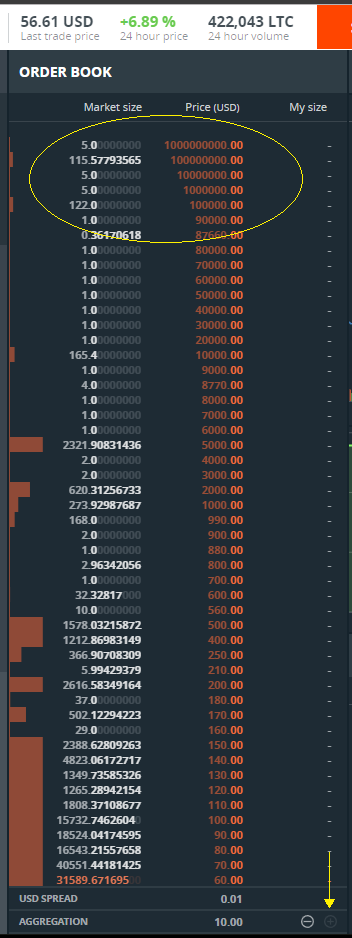Reader Dan K passed this along as a curiosity that might have some significance. Any reader thoughts welcome!
From his e-mail:
GDAX, the trading platform for Coinbase (https://www.coinbase.com/), among the largest trading platforms, recently added a feature to their UI that lets you compress the order book by aggregation.
The UI tool can be seen here:
https://www.gdax.com/trade/LTC-USD
Usually displaying orders in $0.01 increments, the AGGREGATION feature at the bottom of the ORDER BOOK column allows aggregations by selected factors up to $10 (click the ⨁ button until it grays out).
Right now, Litecoin (LTC), is apparently the least traded of the three crypto-currencies Coinbase trades. So compressing the order book by a factor of 1000 lets one peer pretty far across the order book for this currency. Here is a clip of the order book display at $10 aggregation:
So, yeah. Somebody has posted orders aggregating to 5 LTC at the 1 billion dollar price ($5 billion). Only to be exceeded by orders totaling 115.57793565 LTC at 100 million (that’s $115,577,935,650, more than the 2016 state budget of Texas).
This screen clip was taken September 27, 2017 20:03 UTC, since then an additional order for ~5.5 LTC at $300 has bumped the billion dollar bid off of the top; order book fluctuations hide or reveal the high dollar orders.
There could be even higher bids beyond the billion cropped off the top. I looked a few days ago when I first noticed the feature, and the top order aggregate was $10 million.
I am guessing that the primary intent is to provide a base order volume, to buffer the live market against reaching drastic fluctuations leading to deadlocks. Or is it just parked off to the side, hidden or laundering?
Formally, these huge orders are supposed to be backed by actual dollars. Actually, they could be hard-coded into the transaction processor. But more likely, manual entries in a table. Or even more likely, actual orders posted to the system, from accounts whose validation is somehow bypassed, a coded backdoor of sorts (that’s how I would do it, were I to).



Those are just offers at stupid prices in case there is some fat finger order
I think we have a winner.
This is all legal, how? Governments have had a hard time deciding if these cryptocurrencies are the wave of future Weimar, or a tax/money laundering dodge. What about “imputed income”? We are guilty until we prove ourselves innocent. Would the IRS accuse people of an imputed income profit from such non-existent trades in cryptocurrencies? If the digital chain can be audited by the IRS, during discovery, they can prove it one way or another. But if the digital chain can be corrupted by the original administrators, how is this anything but fraud. Not just quantity in original accounts (auto-IPO), but in trades and ownership. Ordinary people are going to know less about digital chain corruption, than we presently know about the Federal Reserve.
The basic idea of the blockchain, that underpins these currencies, is that its distributed and public. Many many systems hold the same ledger and actively verify and update it with each other. No single actor can alter the blockchain to ‘corrupt’ it, unless they controlled more than 51 percent of the mining capacity on the network.
You’re right, there’s no money there, it’s just 5 or 115.57793565 LTC sitting there, asking millions of dollars for one isn’t a crime.
The post (which I wrote) is wrong in saying
The orders in question are backed by a few hundred Litecoins, currently selling around $54. I just didn’t understand what I was looking at :p. Sorry!
I’m not at all sure I understood that post, but it seems to me that sheer scale protects against prosecution, as Wall St. demonstrated in 2009, and that might be what they’re going for.
This is the SMALLEST “coin,” and it’s showing numbers like that? Too big to fail.